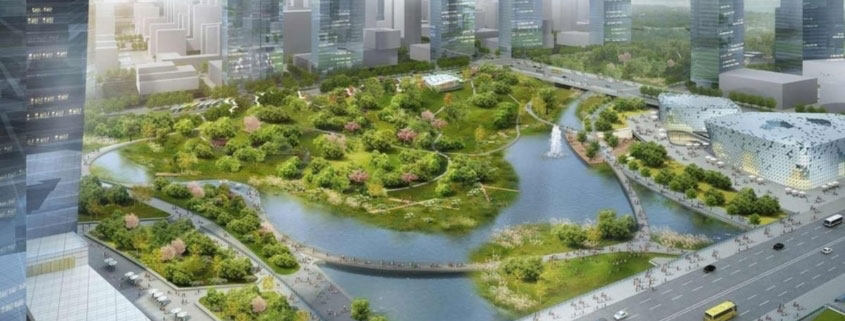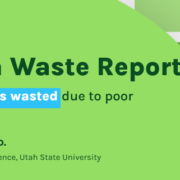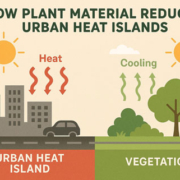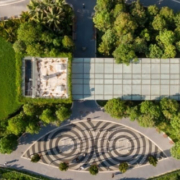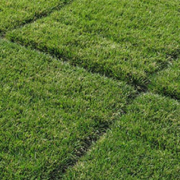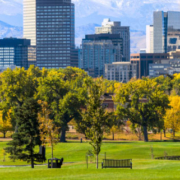Sponge Cities: Designing for Drought, Flood, and Fire in a Changing Climate
As climate extremes become the new “normal”, cities must do more than just make space for people—they need to absorb water, heat, and unexpected environmental conditions. With worsening floods, longer droughts, and wildfires creeping into urban neighborhoods (my heart went out to Los Angeles last summer!), traditional infrastructure just isn’t cutting it anymore.
That’s where the idea of “sponge cities” comes in. Instead of rushing stormwater off streets and into wastewater systems as quickly as possible, sponge cities are designed to soak it up, store it, and put it to good use. Green infrastructure, sponge city approaches like rain gardens, green roofs, permeable pavement, and healthy soils can help reduce flood risk, support vegetation during dry spells, and even buffer fire risk under the right conditions.
Research Highlights
- Sponge Cities are urban areas that use nature-based solutions to reduce flooding and runoff.
- Drought resilience, cooling benefits and natural firebreaks are benefits from Sponge Cities.
- Sponge City infrastructure often costs less than expanding gray systems.
Originally launched as a national initiative in China, sponge cities and related concepts are gaining more and more traction worldwide. In this post, I’ll break down what sponge cities are, how they work, and the challenges that they help us address.
What Exactly IS a Sponge City?
In 2014, the Chinese central government introduced the term sponge city to describe urban areas that use nature-based solutions to reduce urban flooding and runoff pollution and increase rainwater resource usage (Zhai et al., 2021). Similar approaches by other countries have been called “Water Sensitive Urban Design”, “Low Impact Development”, “Sustainable Urban Drainage Systems”, “Nature Based Solutions”, and “Blue-Green Infrastructure” (Hawken et al., 2021). Unlike conventional “gray” infrastructure that channels stormwater away through pipes and drains, cities undertaking these approaches create water systems that are meant to work more like natural systems by allowing rainwater to infiltrate into the ground, be stored in soils and constructed wetlands, or be reused.
Core features include permeable pavement that lets water pass through, green roofs that absorb rainfall, rain gardens and bioswales that filter and slow runoff, restored wetlands that act as natural reservoirs, and vegetated landscapes that cool and stabilize the environment (Chan et al., 2018).
In China, the national Sponge City initiative aimed to retrofit over 30 pilot cities so that at least 70% of stormwater was captured and reused on-site (Chan et al., 2018). Cities like Rotterdam and Melbourne have adopted similar strategies, integrating green infrastructure to tackle flooding and reduce urban heat, while Philadelphia’s “Green City, Clean Waters” program emphasizes decentralized stormwater management to relieve sewer system pressure (Philadelphia Water Department, 2025).
What makes sponge cities powerful is their multifunctionality. Beyond stormwater control, they enhance drought resilience, provide cooling benefits in overheated urban cores, and—when vegetated buffers are incorporated—can even act as firebreaks in wildland-urban interfaces.
As climate extremes grow more intense and frequent, these cities offer a proactive, adaptable example for building urban resilience.
Urban Flood Management
Urban flooding is one of the most difficult challenges facing modern cities and it’s driven by a combination of aging infrastructure, increasingly intense storms, and the widespread and increasing presence of impervious surfaces like roads, parking lots, and rooftops. Traditional “gray” infrastructure—storm drains, pipes, and channels—was designed to move water away as quickly as possible, but in many cities, these systems are undersized or deteriorating, leading to sewer overflows and localized flooding (National Research Council, 2009). Sponge city and similar strategies offer a more adaptable and cost-effective solution by using green infrastructure to increase infiltration, slow runoff, and relieve pressure on wastewater systems.
One great example (mentioned above) is Philadelphia’s Green City, Clean Waters program, which uses rain gardens, tree trenches, and green roofs to manage stormwater at its source. Since its launch in 2011, the program has added over 2,800 “greened” acres, keeping billions of gallons of runoff out of the combined sewer system (Philadelphia Water Department, 2025). These nature-based interventions not only reduce flooding but also improve water quality, enhance urban biodiversity, and provide social benefits like increased green space area (Meerow and Newell, 2017).
From a policy standpoint, sponge city-type infrastructure often costs less than expanding gray systems and delivers additional benefits. Investing in permeable pavements, bioswales, and vegetated corridors protects critical infrastructure and property, while also restoring ecological function in highly urbanized environments. These strategies are essential tools in building more flood-resilient communities.
Urban Drought Management
Drought may not come with the same drama as floods, but its impacts are just as devastating and far more persistent. In urban areas, drought is often intensified by the way water is lost, not just because of a lack of precipitation, but because of runoff from impervious surfaces and inefficient irrigation.
Sponge city design approaches offer proactive solutions, transforming urban landscapes into systems that capture, store, and reuse water onsite. Features like bioswales, cisterns, permeable pavement, and healthy soils help keep stormwater in place, reducing runoff and enhancing water availability during dry periods (Zhan et al., 2021).
Even turfgrasses, trees, and other vegetation—when appropriately selected and managed—act as “virtual” reservoirs, cooling the environment and keeping water in plant biomass and soils. We also know that vegetated areas improve soil moisture retention and reduce the urban heat island effects, helping to mitigate drought stress (Braun et al., 2024).
For water agencies and municipalities, these approaches present an opportunity to transition from reactive water conservation measures to climate-adaptive design. By providing incentives, design standards, and pilot programs, water agencies can promote sponge city-like infrastructure that supports both water savings and the maintenance (and hopefully expansion) of green space. In drought-prone regions, these strategies are essential to preserving livable communities that are sustainable.
Fire!
Landscape design can also play a critical role in enhancing fire resilience, especially in wildland-urban interface (WUI) zones. Sadly, the 2025 fires in Los Angeles made this abundantly clear. Contrary to the assumption that vegetation always increases fire risk, well-designed, irrigated, and maintained green spaces can slow fire spread and act as defensible zones around structures (Quarles et al., 2010). Sponge city-like approaches, which prioritize soil moisture retention, shading, and water infiltration, can also help in designing landscapes that moderate microclimates, maintain higher humidity, and reduce fire potential.
Drought-adapted plants, planted in well-spaced zones and supported by efficient irrigation, can also reduce flammable fuel loads near structures while providing other ecosystem benefits. Strategic buffers of up to 100 feet, especially when properly maintained, act as natural fuel breaks (Syphard et al., 2014). In contrast, replacing plants with combustible mulches near structures can increase surface temperatures and allow fires to move more quickly across landscapes due to lack of moisture and reflective heat (Quarles and Smith, 2011).
Coordinating landscape plans with fire risk zones is essential and vegetation management plans should consider plant selection, spacing, and irrigation access, especially in vulnerable communities. Incorporating fire resilience into sponge city-like strategies helps protect lives, property, and ecosystem health as wildfires become more frequent and intense.
It’s the Economy AND the Environment
Sponge city-like design doesn’t just manage water—it delivers a range of economic and environmental co-benefits that make urban areas healthier, more livable, and more financially sustainable. One of the most significant benefits is urban cooling. Green spaces that include turfgrasses, trees, and other vegetation help reduce both surface and ambient air temperatures through shading and evapotranspiration, which can significantly cut air conditioning costs and mitigate the urban heat island effects (Shashua-Bar et al., 2009). This cooling effect is particularly beneficial in lower-income areas that may lack adequate tree canopy and suffer disproportionately from extreme heat.
Sponge city approaches also support urban biodiversity, creating habitat for birds, pollinators, and beneficial insects through thoughtful landscape design. Even small patches of green space have been shown to increase species richness and support ecological resilience (Aronson et al., 2017).
From a utility perspective, the environmental services provided by green infrastructure also extend to air and water quality. Plants trap particulate pollution, while root systems and healthy soils filter stormwater, improve downstream water quality, and reduce treatment burdens (Berland et al., 2017). These services reduce the need for expensive gray infrastructure upgrades, like larger storm pipes or expanded wastewater treatment capacity, offering cities long-term returns on investments through lower maintenance costs and deferred capital expenditures.
The cumulative result is a resilient, functional urban environment with fewer infrastructure demands, healthier residents, and stronger ecosystems—a win-win for both people and the planet.
Conclusion
“Sponge city” is not just a sustainability buzzword. These cities, and the design approaches that they represent, are necessary responses to the escalating challenges of climate extremes. As urban areas face more frequent and severe droughts, floods, and wildfires, traditional infrastructure alone cannot keep up with the challenges.
The sponge city approach offers a smarter way forward, using multifunctional green infrastructure to manage water, reduce heat, enhance biodiversity, and strengthen community resilience. These systems don’t just solve one problem, they provide co-benefits that improve public health, reduce infrastructure costs, and make cities more livable for everyone.
The tools, technologies, and design strategies already exist and now is the time to implement them at scale. Landscape professionals, water authorities, and local governments have a unique opportunity—and responsibility—to lead this transition. By adopting sponge city-like principles today, we will have the foundation for healthier, safer, and more resilient communities tomorrow.
References
Aronson, M.F.J., C.A. Lepczyk, K.L. Evans, M.A. Goddard, S.B. Lerman, J.S. MacIvor, C.H. Nilon and T. Vargo. Biodiversity in the city: Key challenges for urban green space management. Frontiers in Ecology and the Environment 15(4): 173-224.
Berland, A., S.A. Shiflett, W.D. Shuster, A.S. Garmestani, H.C. Goddard, D.L. Herrmann and M.E. Hopton. 2017. The role of trees in urban stormwater management. Landscape and Urban Planning 162:167-177.
Chan, F.K.S., J.A. Griffiths, D. Higgitt, S. Xu, F. Zhu, Y. Tang, Y. Xu and C.R. Thorne. 2018. “Sponge City” in China—a breakthrough of planning and flood risk management in the urban context. Land Use Policy 76:772–778.
Hawken, S., S.M.E. Sepasgozar, V. Prodanovic, J. Jing, A. Bakelmun, B. Avazpour, S. Che, K. Zhang. 2021. What makes a successful Sponge City project? Expert perceptions of critical factors in integrated urban water management in the Asia-Pacific. Sustainable Cities and Society 75:103317.
Meerow, S. and J.P. Newell. 2017. Spatial planning for multifunctional green infrastructure: Growing resilience in Detroit. Landscape and Urban Planning 159:62-75.
National Research Council. 2009. Urban Stormwater Management in the United
States. Washington, DC. The National Academies Press.
Philadelphia Water Department. 2025. Green city, clean waters. Retrieved April 21, 2025. https://water.phila.gov/green-city/.
Quarles, S.L., Y. Valachovic, G.M. Nakamura, G.A. Nader, and M.J. De Lasaux. 2010. Home survival in wildfire-prone areas: building materials and design considerations. University of California Agriculture and Natural Resources Publication 8393.
Quarles, S. and E. Smith. 2011. The combustibility of landscape mulches. University of Nevada Cooperative Extension Publication SP-11-04.
Syphard, A., T.J. Brennan and J.E. Keeley. 2014. The role of defensible space for residential structure protection during wildfires. International Journal of Wildland Fire. 23:1165-1175.
Zhai, J., J. Ren, M. Xi, X. Tang and Y. Zhang. 2021. Multiscale watershed landscape infrastructure: Integrated system design for sponge city development. Urban Forestry and Urban Greening 60:127060.

